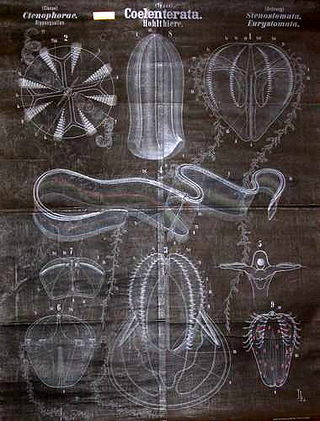
Digenea is a class of trematodes in the Platyhelminthes phylum, consisting of parasitic flatworms with a syncytial tegument and, usually, two suckers, one ventral and one oral. Adults commonly live within the digestive tract, but occur throughout the organ systems of all classes of vertebrates. Once thought to be related to the Monogenea, it is now recognised that they are closest to the Aspidogastrea and that the Monogenea are more closely allied with the Cestoda. Around 6,000 species have been described to date.
Matthias Looß is a German nordic combined skier who competed from 1996 to 2001. At the 1998 Winter Olympics in Nagano, he finished sixth in the 4 x 5 km team event.

Arthur Looss was a German zoologist and parasitologist. Looss was born in 1861 in Chemnitz, and was educated both there and in Łódź, Poland. Thereafter, he studied at the University of Leipzig, where he received a doctorate for his study of trematodes.

Plagiorchiida is a large order of trematodes, synonymous to Echinostomida. They belong to the Digenea, a large subclass of flukes. This order contains relatively few significant parasites of humans.

Echinostomata is a suborder of the parasitic flatworm order Plagiorchiida. The suborder contains numerous species that are parasitic in humans.

Opisthorchiidae is a family of digenean trematodes. Opisthorchiidae have cosmopolitan distribution.

Heterophyidae is a family of intestinal trematodes in the order Plagiorchiida.
Haploporidae is a family of trematodes in the order Plagiorchiida.
Telorchiidae is a family of trematode parasites.

Heterophyes is a genus of trematodes, or fluke worms, in the family Heterophyidae.
Philophthalmidae is a family of trematodes in the order Plagiorchiida.

Echinostomatidae is a family of trematodes in the order Plagiorchiida, first described in 1899.
Gorgoderidae is a family of trematodes in the order Plagiorchiida.
Allocreadium is a genus of trematodes belonging to the family Allocreadiidae. The genus was first described by Arthur Looss in 1900. The genus has almost cosmopolitan distribution.

Allocreadiidae is a family of flatworms belonging to the order Plagiorchiida. In their adult stage they parasitize teleosts through their digestive system; they can also parasitize other vertebrates in freshwater ecosystems such as frogs, salamanders, and snakes. Allocreadiidae are distinguished from other Trematoda in the cercarial stage, where the cercaria have both an eye-spot and a stylet. The cercaria of Allocreadiidae also develop in lamellibranchs, whereas many other trematodes develop in gastropods.
Azygiida is an order of flatworms belonging to the class Rhabditophora.
Dicrocoelium hospes is a species of flatworms belonging to the family Dicrocoeliidae.

Dicrocoeliidae is a family of flatworms belonging to the order Plagiorchiida.
Hemiuridae is a family of trematodes belonging to the order Plagiorchiida containing 514 described species.

Philophthalmus is a genus of trematodes belonging to the family Philophthalmidae.











